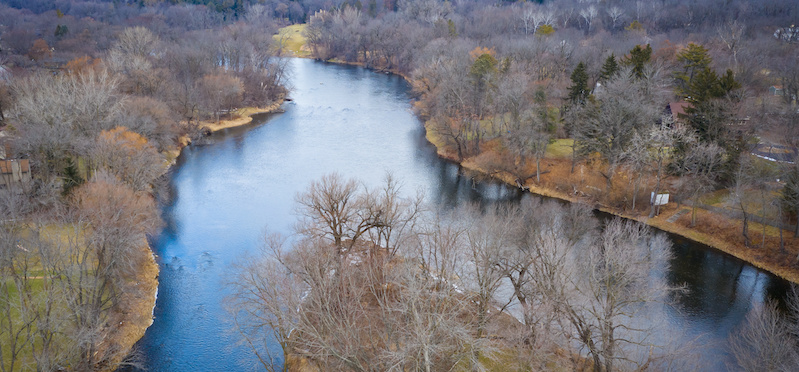
In 1968, Mayor Henry Maier called the Milwaukee River “an almost dead artery.” A year later, in Cleveland, the Cuyahoga River, fouled by industrial pollution, caught fire. Even in our nation’s capital, the Potomac River was so dangerous, falling in required a tetanus shot. Across the U.S., a rising public consciousness of dangerously unsafe waters was furthered by an emergent environmental movement. It wasn’t until the first Earth Day in 1970 that Congress was finally stirred into action. After passing several sweeping environmental protections, in 1972, Congress passed the Clean Water Act (CWA).
The Clean Water Act promised us “fishable and swimmable” waters by 1983 and the complete elimination of all pollution into navigable waters by 1985 – a promise that has not yet been met. But great progress has certainly been made towards these ambitious objectives. The Clean Water Act set limits on dumping toxic pollutants from “point sources” such as factories, industrial sites, or municipalities, into our waterways, levying significant fines on those that do not comply. Through EPA-set criteria, the Act created minimum water quality standards nationwide, as well as those for swimming and fishing. This landmark legislation also funded the construction of sewage treatment plants across the U.S. As a result, 700 billion pounds of pollution have been kept out of our nation’s rivers and the number of waters that meet clean water goals has doubled since 1972.
By almost any measure the Clean Water Act is a success story, but one key provision paved the way for accountability. Each state is responsible for setting its own water quality standards. But federal lawmakers understood that often underfunded state agencies would be hard-pressed to monitor water quality throughout their respective states. The CWA’s Section 505 addressed that weakness by allowing for citizens – individuals or non-governmental organizations – to bring lawsuits to stop illegal pollution discharges. That powerful statutory tool gave rise to community action groups like Milwaukee Riverkeeper, and other Waterkeepers across the country, demanding action to conserve and protect our vital waters.
Milwaukee Riverkeeper’s “community watchdog” status has been an essential ingredient in its advocacy work, including past success around dam removals and enforcement of permit requirements. Most recently Milwaukee Riverkeeper and its many supporters watchdogged the December 2021 Komatsu oil spill into the Menomonee River. It was the first organization contacted by media about the spill, and the first to question Komatsu’s tardy cleanup response. Milwaukee Riverkeeper has weighed in on how to limit environmental damage that will likely be caused by the proposed expansion of I-94 in Milwaukee. By hosting events like the annual river cleanup, Milwaukee Riverkeeper encourages citizen engagement in protecting the Milwaukee River Basin. This year, more than 4,000 volunteers removed over 110,000 lbs. of trash from the Basin’s three rivers. Scores of “community scientist” volunteers each year wade into area rivers, tributary creeks and streams to test for pollutants and monitor the health of our waters. Their findings are sent to the state’s Department of Natural Resources to help inform how its resources are best utilized to protect our rivers, and are key to shaping their annual report card on the health of the Basin.
The Clean Water Act has had a profoundly positive impact on the quality of our waters and our lives even if, as critics rightly note, progress has been uneven. Despite that more than 50% of our waters remain impaired and our urban waterways, many of them running through communities of color, remain ecologically degraded, its final chapter is yet to be written. The next 50 must be focused on one of the greatest contributors to water pollution, stormwater runoff. That includes agricultural runoff which produces phosphorus-laden, fish-killing algae blooms and undrinkable water (see: Toledo, OH). Stormwater contamination, such as road salt runoff from city streets and parking lots, also needs to be regulated. Divisive issues such as which waters are protected under the CWA, including wetlands and seasonal standing waters that are part and parcel of the ecosystem, have to be agreed on in a bipartisan nature. One good sign: $50 billion allocated to the EPA for water programs in the 2022 Bipartisan Infrastructure Act.
We all need clean water to live and thrive, even the economy benefits. We all deserve equal access to clean water. In these divisive times, Americans and our elected representatives must still come together to agree on the importance of protecting our waters. Your voice and your vote are critical this November.
The Clean Water Act has brought us far in its 50 years and as we begin the next, it is up to all of us to work together to achieve the goals of the Act and swimmable, fishable waters.
About the Author. Author Juan Alsace is a retired Career Member of the U.S. Senior Foreign Service. His 32-year career included overseas service in Latin America, Europe and Iraq. Domestic assignments included working on U.S. foreign policy towards Lebanon, Central Asia and the Caribbean, as well as investigation of war crimes. Mr. Alsace also taught strategic leadership at the National Defense University. He twice served as U.S. Consul General, first in Barcelona, Spain and, in his last posting, Toronto, Canada. In Toronto, Mr. Alsace strengthened cooperation on cross-border, binational issues impacting the Great Lakes region, including those pertaining to water, a life-long interest. Mr. Alsace returned to Milwaukee in 2018; both he and his wife of 42 years, Nancy, are Marquette University graduates.
Mr. Alsace is current Vice-President on MRK’s Board of Directors and serves on the Marketing and Fundraising Committee
